Nicholas P. Cheremisinoff. Handbook of Solid Waste Management and Waste Minimization Technologies
Подождите немного. Документ загружается.

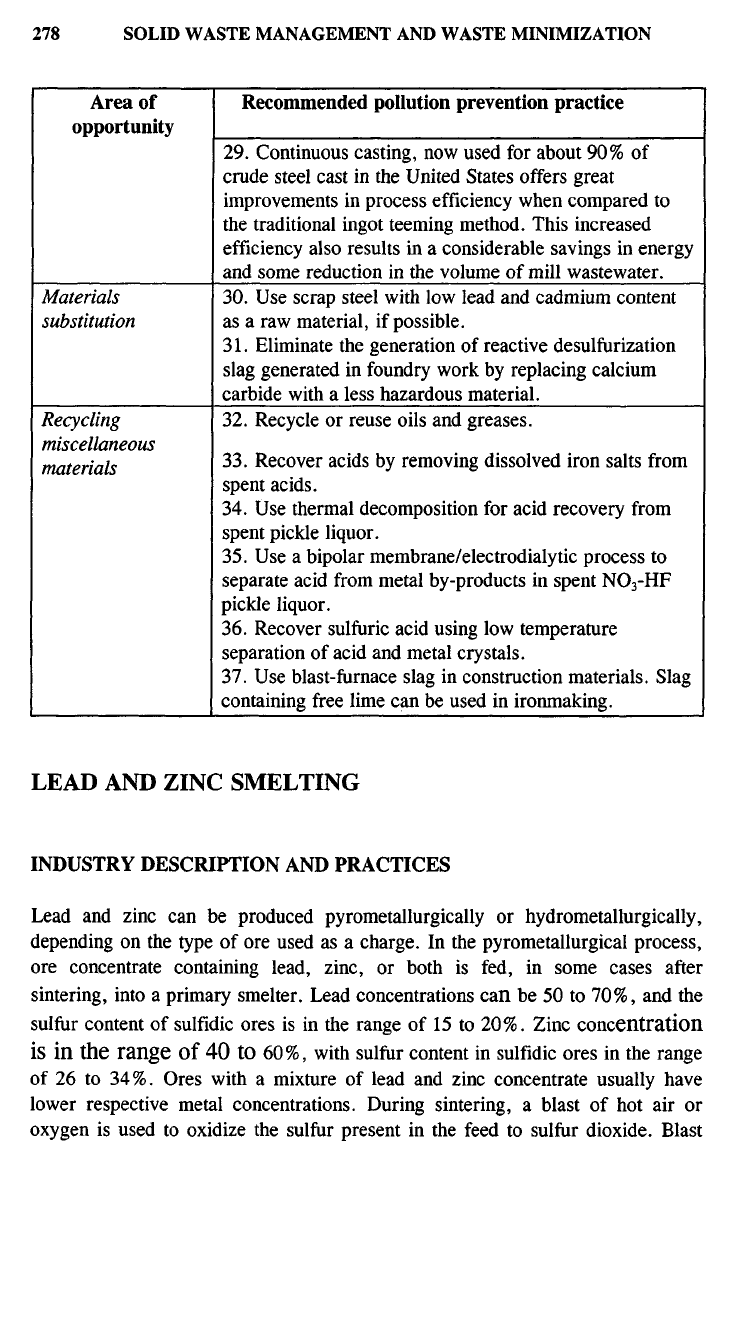
Area of
opportunity
Materials
substitution
Recycling
miscellaneous
materials
Recommended pollution prevention practice
29.
Continuous casting, now used for about 90% of
crude steel cast in the United States offers great
improvements in process efficiency when compared to
the traditional ingot teeming method. This increased
efficiency also results in a considerable savings in energy
and some reduction in the volume of mill wastewater.
30.
Use scrap steel with low lead and cadmium content
as a raw material, if possible.
31.
Eliminate the generation of reactive desulfurization
slag generated in foundry work by replacing calcium
carbide with a less hazardous material.
32.
Recycle or reuse oils and greases.
33.
Recover acids by removing dissolved iron salts from
spent acids.
34.
Use thermal decomposition for acid recovery from
spent pickle liquor.
35.
Use a bipolar membrane/electrodialytic process to
separate acid from metal by-products in spent NO
3
-HF
pickle liquor.
36.
Recover sulfuric acid using low temperature
separation of acid and metal crystals.
37.
Use blast-furnace slag in construction materials. Slag
containing free lime can be used in ironmaking.
LEAD AND ZINC SMELTING
INDUSTRY DESCRIPTION AND PRACTICES
Lead and zinc can be produced pyrometallurgically or hydrometallurgically,
depending on the type of ore used as a charge. In the pyrometallurgical process,
ore concentrate containing lead, zinc, or both is fed, in some cases after
sintering, into a primary smelter. Lead concentrations can be 50 to 70%, and the
sulfur content of sulfidic ores is in the range of 15 to 20%. Zinc concentration
is in the range of 40 to 60%, with sulfur content in sulfidic ores in the range
of 26 to 34%. Ores with a mixture of lead and zinc concentrate usually have
lower respective metal concentrations. During sintering, a blast of hot air or
oxygen is used to oxidize the sulfur present in the feed to sulfur dioxide. Blast
Next Page
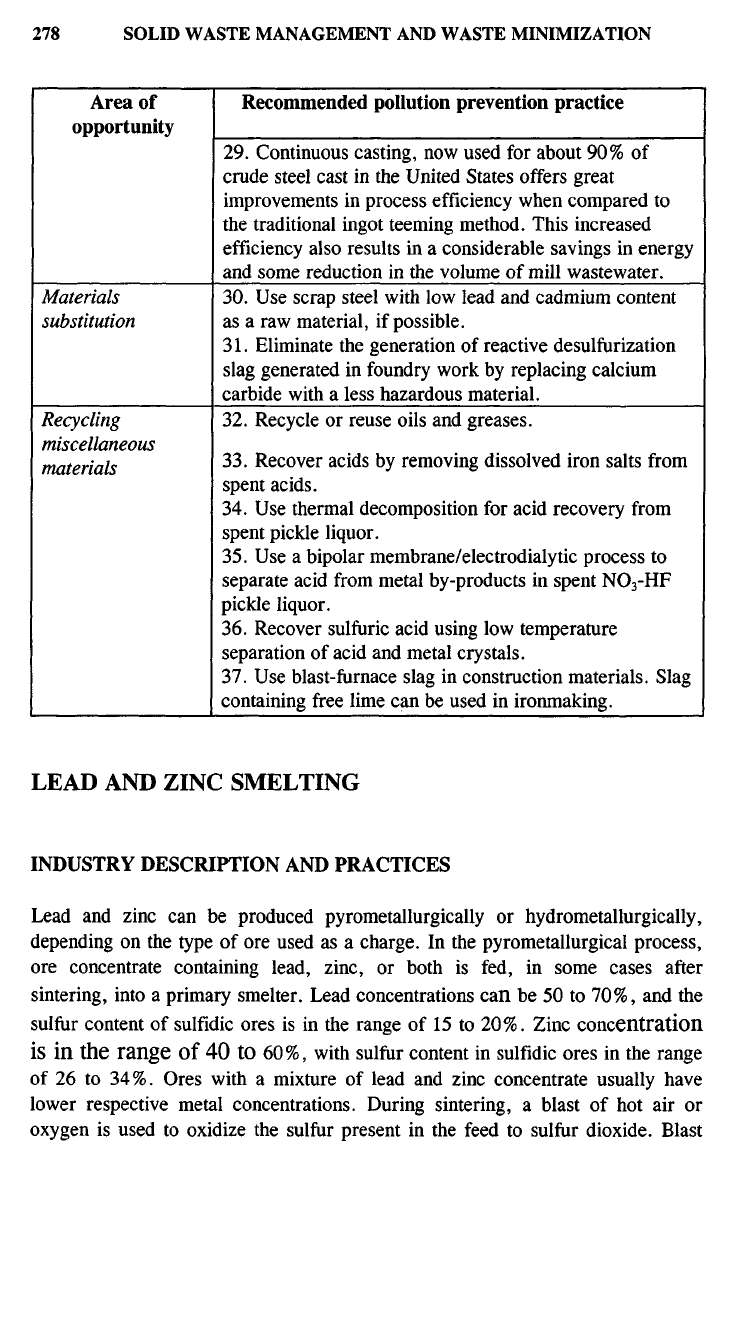
Area of
opportunity
Materials
substitution
Recycling
miscellaneous
materials
Recommended pollution prevention practice
29.
Continuous casting, now used for about 90% of
crude steel cast in the United States offers great
improvements in process efficiency when compared to
the traditional ingot teeming method. This increased
efficiency also results in a considerable savings in energy
and some reduction in the volume of mill wastewater.
30.
Use scrap steel with low lead and cadmium content
as a raw material, if possible.
31.
Eliminate the generation of reactive desulfurization
slag generated in foundry work by replacing calcium
carbide with a less hazardous material.
32.
Recycle or reuse oils and greases.
33.
Recover acids by removing dissolved iron salts from
spent acids.
34.
Use thermal decomposition for acid recovery from
spent pickle liquor.
35.
Use a bipolar membrane/electrodialytic process to
separate acid from metal by-products in spent NO
3
-HF
pickle liquor.
36.
Recover sulfuric acid using low temperature
separation of acid and metal crystals.
37.
Use blast-furnace slag in construction materials. Slag
containing free lime can be used in ironmaking.
LEAD AND ZINC SMELTING
INDUSTRY DESCRIPTION AND PRACTICES
Lead and zinc can be produced pyrometallurgically or hydrometallurgically,
depending on the type of ore used as a charge. In the pyrometallurgical process,
ore concentrate containing lead, zinc, or both is fed, in some cases after
sintering, into a primary smelter. Lead concentrations can be 50 to 70%, and the
sulfur content of sulfidic ores is in the range of 15 to 20%. Zinc concentration
is in the range of 40 to 60%, with sulfur content in sulfidic ores in the range
of 26 to 34%. Ores with a mixture of lead and zinc concentrate usually have
lower respective metal concentrations. During sintering, a blast of hot air or
oxygen is used to oxidize the sulfur present in the feed to sulfur dioxide. Blast
Previous Page
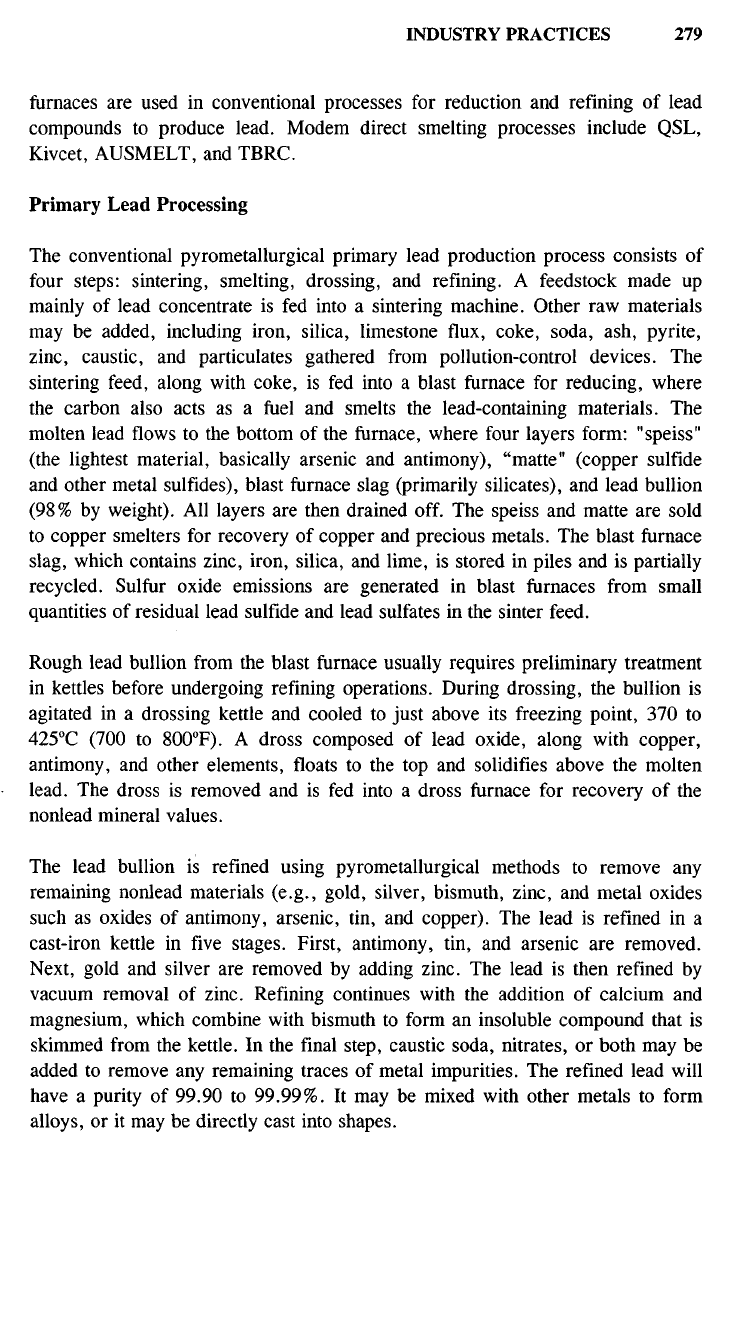
furnaces are used in conventional processes for reduction and refining of lead
compounds to produce lead. Modem direct smelting processes include QSL,
Kivcet, AUSMELT, and TBRC.
Primary Lead Processing
The conventional pyrometallurgical primary lead production process consists of
four steps: sintering, smelting, drossing, and refining. A feedstock made up
mainly of lead concentrate is fed into a sintering machine. Other raw materials
may be added, including iron, silica, limestone flux, coke, soda, ash, pyrite,
zinc,
caustic, and particulates gathered from pollution-control devices. The
sintering feed, along with coke, is fed into a blast furnace for reducing, where
the carbon also acts as a fuel and smelts the lead-containing materials. The
molten lead flows to the bottom of the furnace, where four layers form: "speiss"
(the lightest material, basically arsenic and antimony), "matte" (copper sulfide
and other metal sulfides), blast furnace slag (primarily silicates), and lead bullion
(98%
by weight). All layers are then drained off. The speiss and matte are sold
to copper smelters for recovery of copper and precious metals. The blast furnace
slag, which contains zinc, iron, silica, and lime, is stored in piles and is partially
recycled. Sulfur oxide emissions are generated in blast furnaces from small
quantities of residual lead sulfide and lead sulfates in the sinter feed.
Rough lead bullion from the blast furnace usually requires preliminary treatment
in kettles before undergoing refining operations. During drossing, the bullion is
agitated in a drossing kettle and cooled to just above its freezing point, 370 to
425
0
C (700 to 800
0
F). A dross composed of lead oxide, along with copper,
antimony, and other elements, floats to the top and solidifies above the molten
lead. The dross is removed and is fed into a dross furnace for recovery of the
nonlead mineral values.
The lead bullion is refined using pyrometallurgical methods to remove any
remaining nonlead materials (e.g., gold, silver, bismuth, zinc, and metal oxides
such as oxides of antimony, arsenic, tin, and copper). The lead is refined in a
cast-iron kettle in five stages. First, antimony, tin, and arsenic are removed.
Next, gold and silver are removed by adding zinc. The lead is then refined by
vacuum removal of zinc. Refining continues with the addition of calcium and
magnesium, which combine with bismuth to form an insoluble compound that is
skimmed from the kettle. In the final step, caustic soda, nitrates, or both may be
added to remove any remaining traces of metal impurities. The refined lead will
have a purity of 99.90 to 99.99%. It may be mixed with other metals to form
alloys, or it may be directly cast into shapes.
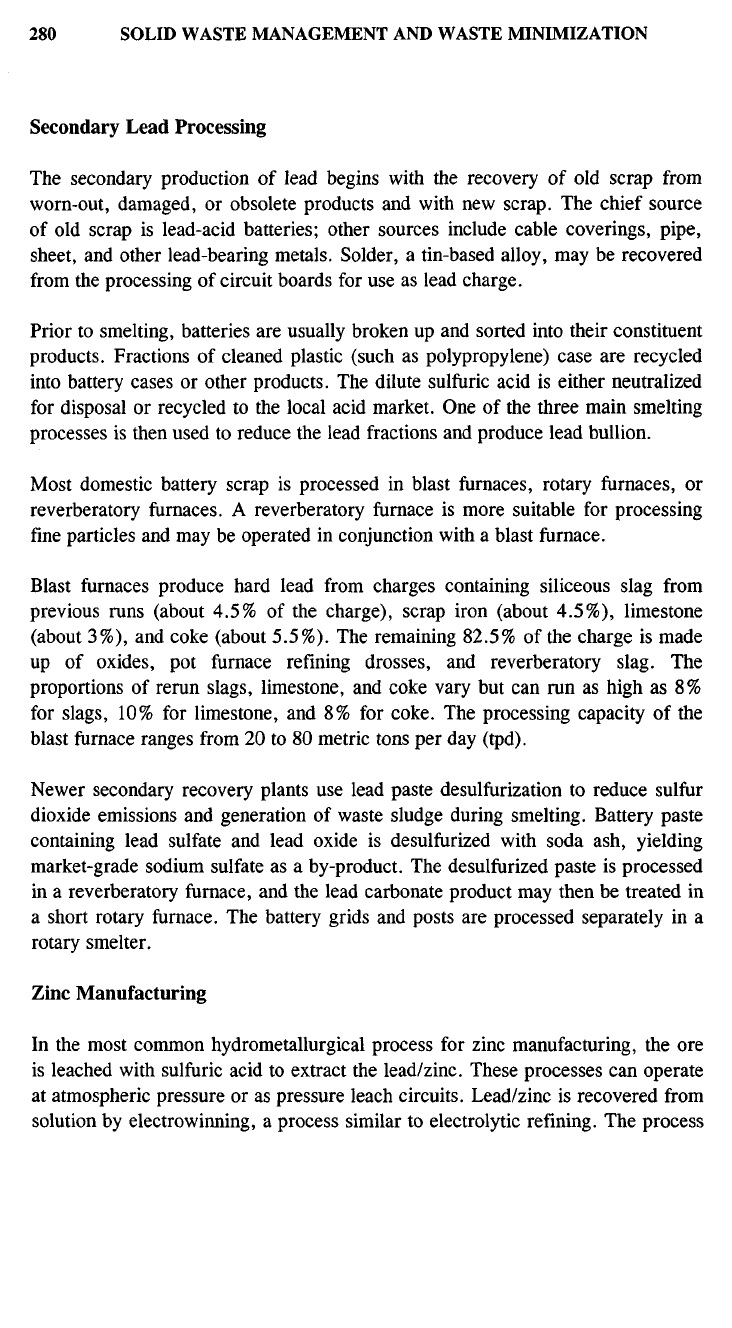
Secondary Lead Processing
The secondary production of lead begins with the recovery of old scrap from
worn-out, damaged, or obsolete products and with new scrap. The chief source
of old scrap is lead-acid batteries; other sources include cable coverings, pipe,
sheet, and other lead-bearing metals. Solder, a tin-based alloy, may be recovered
from the processing of circuit boards for use as lead charge.
Prior to smelting, batteries are usually broken up and sorted into their constituent
products. Fractions of cleaned plastic (such as polypropylene) case are recycled
into battery cases or other products. The dilute sulfuric acid is either neutralized
for disposal or recycled to the local acid market. One of the three main smelting
processes is then used to reduce the lead fractions and produce lead bullion.
Most domestic battery scrap is processed in blast furnaces, rotary furnaces, or
reverberatory furnaces. A reverberatory furnace is more suitable for processing
fine particles and may be operated in conjunction with a blast furnace.
Blast furnaces produce hard lead from charges containing siliceous slag from
previous runs (about 4.5% of the charge), scrap iron (about 4.5%), limestone
(about 3%), and coke (about 5.5%). The remaining 82.5% of the charge is made
up of oxides, pot furnace refining drosses, and reverberatory slag. The
proportions of rerun slags, limestone, and coke vary but can run as high as 8%
for slags, 10% for limestone, and 8% for coke. The processing capacity of the
blast furnace ranges from 20 to 80 metric tons per day (tpd).
Newer secondary recovery plants use lead paste desulfurization to reduce sulfur
dioxide emissions and generation of waste sludge during smelting. Battery paste
containing lead sulfate and lead oxide is desulfurized with soda ash, yielding
market-grade sodium sulfate as a by-product. The desulfurized paste is processed
in a reverberatory furnace, and the lead carbonate product may then be treated in
a short rotary furnace. The battery grids and posts are processed separately in a
rotary smelter.
Zinc Manufacturing
In the most common hydrometallurgical process for zinc manufacturing, the ore
is leached with sulfuric acid to extract the lead/zinc. These processes can operate
at atmospheric pressure or as pressure leach circuits. Lead/zinc is recovered from
solution by electrowinning, a process similar to electrolytic refining. The process
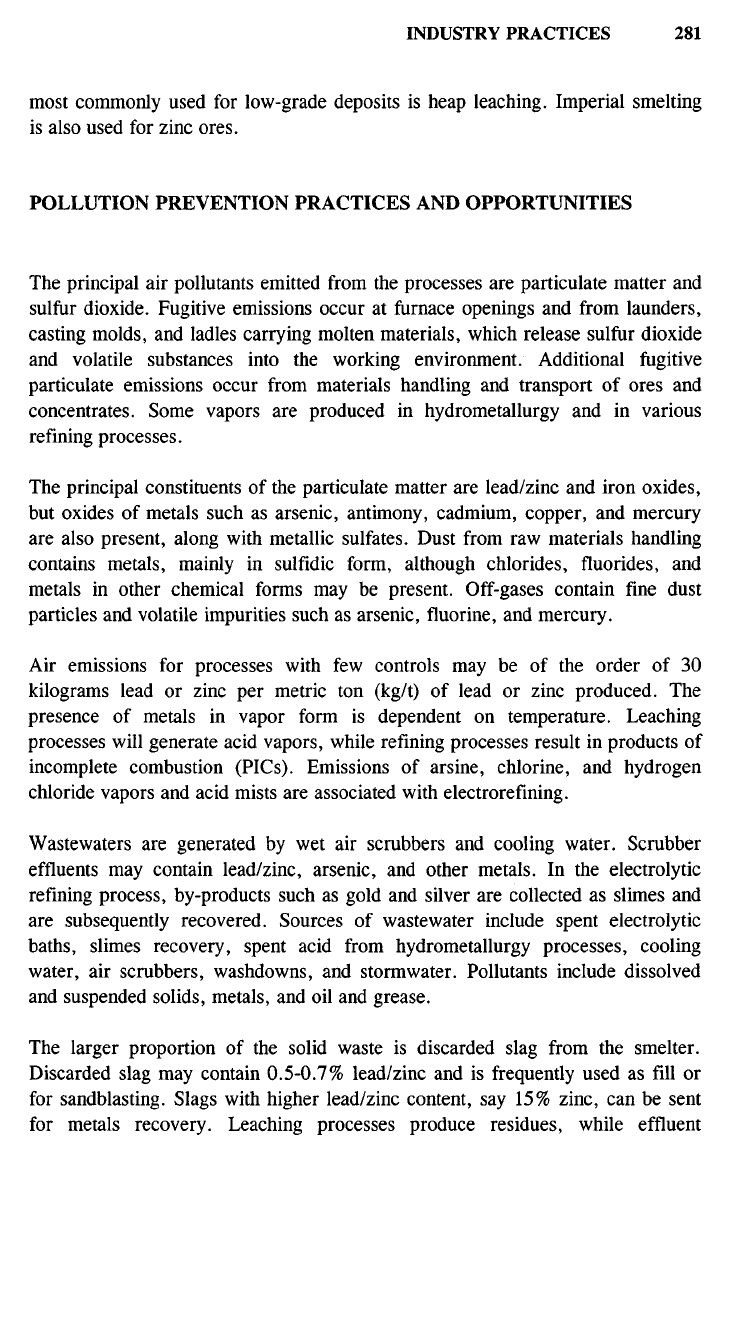
most commonly used for low-grade deposits is heap leaching. Imperial smelting
is also used for zinc ores.
POLLUTION PREVENTION PRACTICES AND OPPORTUNITIES
The principal air pollutants emitted from the processes are particulate matter and
sulfur dioxide. Fugitive emissions occur at furnace openings and from launders,
casting molds, and ladles carrying molten materials, which release sulfur dioxide
and volatile substances into the working environment. Additional fugitive
particulate emissions occur from materials handling and transport of ores and
concentrates. Some vapors are produced in hydrometallurgy and in various
refining processes.
The principal constituents of the particulate matter are lead/zinc and iron oxides,
but oxides of metals such as arsenic, antimony, cadmium, copper, and mercury
are also present, along with metallic sulfates. Dust from raw materials handling
contains metals, mainly in sulfidic form, although chlorides, fluorides, and
metals in other chemical forms may be present. Off-gases contain fine dust
particles and volatile impurities such as arsenic, fluorine, and mercury.
Air emissions for processes with few controls may be of the order of 30
kilograms lead or zinc per metric ton (kg/t) of lead or zinc produced. The
presence of metals in vapor form is dependent on temperature. Leaching
processes will generate acid vapors, while refining processes result in products of
incomplete combustion (PICs). Emissions of arsine, chlorine, and hydrogen
chloride vapors and acid mists are associated with electrorefining.
Waste water
s
are generated by wet air scrubbers and cooling water. Scrubber
effluents may contain lead/zinc, arsenic, and other metals. In the electrolytic
refining process, by-products such as gold and silver are collected as slimes and
are subsequently recovered. Sources of waste water include spent electrolytic
baths,
slimes recovery, spent acid from hydrometallurgy processes, cooling
water, air scrubbers, washdowns, and stormwater. Pollutants include dissolved
and suspended solids, metals, and oil and grease.
The larger proportion of the solid waste is discarded slag from the smelter.
Discarded slag may contain 0.5-0.7% lead/zinc and is frequently used as fill or
for sandblasting. Slags with higher lead/zinc content, say 15% zinc, can be sent
for metals recovery. Leaching processes produce residues, while effluent
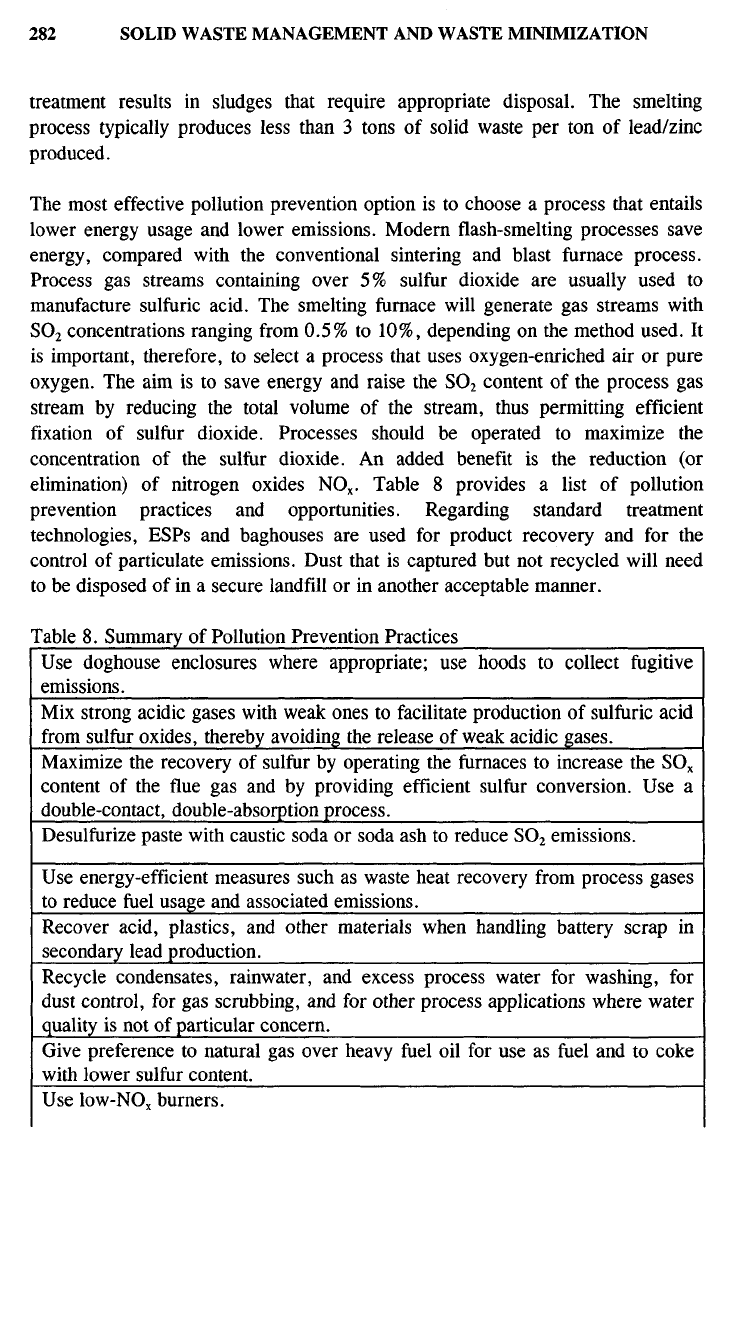
treatment results in sludges that require appropriate disposal. The smelting
process typically produces less than 3 tons of solid waste per ton of lead/zinc
produced.
The most effective pollution prevention option is to choose a process that entails
lower energy usage and lower emissions. Modern flash-smelting processes save
energy, compared with the conventional sintering and blast furnace process.
Process gas streams containing over 5% sulfur dioxide are usually used to
manufacture sulfuric acid. The smelting furnace will generate gas streams with
SO
2
concentrations ranging from 0.5% to 10%, depending on the method used. It
is important, therefore, to select a process that uses oxygen-enriched air or pure
oxygen. The aim is to save energy and raise the SO
2
content of the process gas
stream by reducing the total volume of the stream, thus permitting efficient
fixation of sulfur dioxide. Processes should be operated to maximize the
concentration of the sulfur dioxide. An added benefit is the reduction (or
elimination) of nitrogen oxides NO
x
. Table 8 provides a list of pollution
prevention practices and opportunities. Regarding standard treatment
technologies, ESPs and baghouses are used for product recovery and for the
control of particulate emissions. Dust that is captured but not recycled will need
to be disposed of in a secure landfill or in another acceptable manner.
Table 8. Summary of Pollution Prevention Practices
Use doghouse enclosures where appropriate; use hoods to collect fugitive
emissions.
Mix strong acidic gases with weak ones to facilitate production of sulfuric acid
from sulfur oxides, thereby avoiding the release of weak acidic gases.
Maximize the recovery of sulfur by operating the furnaces to increase the SO
x
content of the flue gas and by providing efficient sulfur conversion. Use a
double-contact, double-absorption process.
Desulfurize paste with caustic soda or soda ash to reduce SO
2
emissions.
Use energy-efficient measures such as waste heat recovery from process gases
to reduce fuel usage and associated emissions.
Recover acid, plastics, and other materials when handling battery scrap in
secondary lead production.
Recycle condensates, rainwater, and excess process water for washing, for
dust control, for gas scrubbing, and for other process applications where water
quality is not of particular concern.
Give preference to natural gas over heavy fuel oil for use as fuel and to coke
with lower sulfur content.
Use low-NO
x
burners.
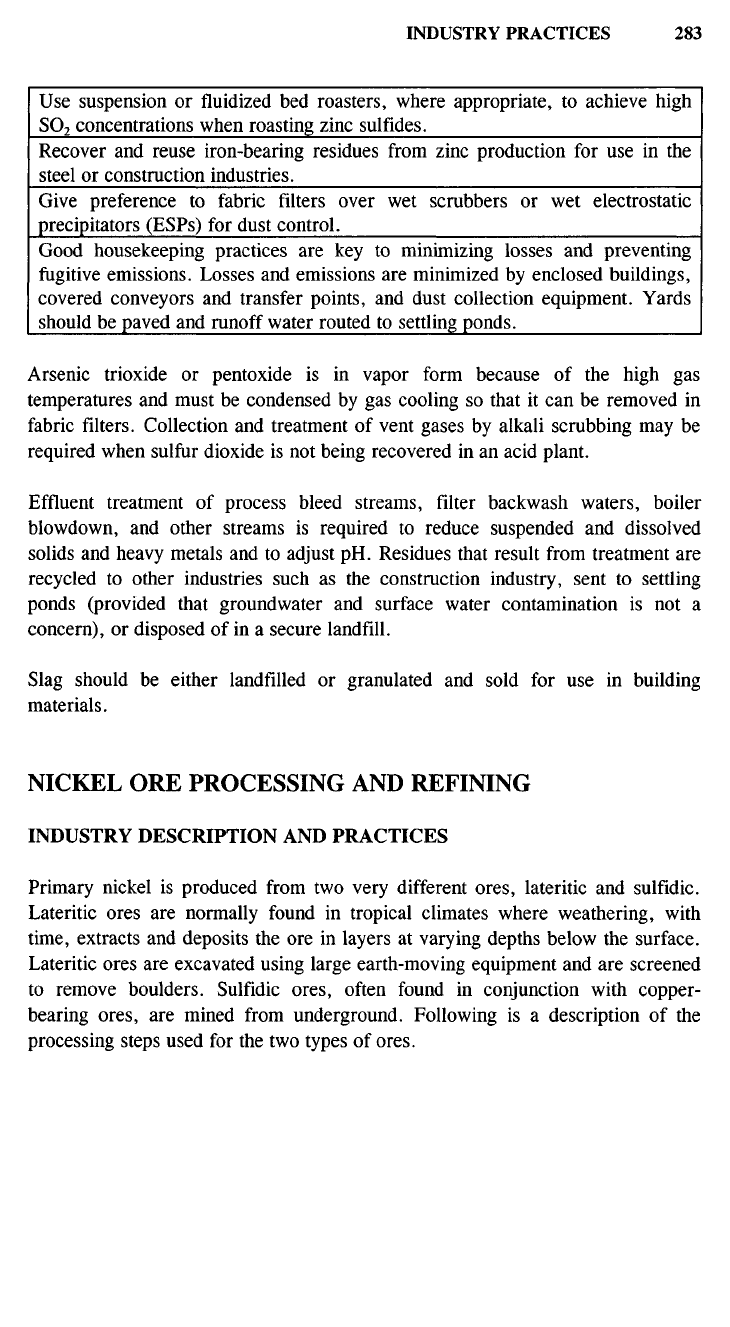
Use suspension or fluidized bed roasters, where appropriate, to achieve high
SO
2
concentrations when roasting zinc sulfides.
Recover and reuse iron-bearing residues from zinc production for use in the
steel or construction industries.
Give preference to fabric filters over wet scrubbers or wet electrostatic
precipitators (ESPs) for dust control.
Good housekeeping practices are key to minimizing losses and preventing
fugitive emissions. Losses and emissions are minimized by enclosed buildings,
covered conveyors and transfer points, and dust collection equipment. Yards
should be paved and runoff water routed to settling ponds.
Arsenic trioxide or pentoxide is in vapor form because of the high gas
temperatures and must be condensed by gas cooling so that it can be removed in
fabric filters. Collection and treatment of vent gases by alkali scrubbing may be
required when sulfur dioxide is not being recovered in an acid plant.
Effluent treatment of process bleed streams, filter backwash waters, boiler
blowdown, and other streams is required to reduce suspended and dissolved
solids and heavy metals and to adjust pH. Residues that result from treatment are
recycled to other industries such as the construction industry, sent to settling
ponds (provided that groundwater and surface water contamination is not a
concern), or disposed of in a secure landfill.
Slag should be either landfilled or granulated and sold for use in building
materials.
NICKEL ORE PROCESSING AND REFINING
INDUSTRY DESCRIPTION AND PRACTICES
Primary nickel is produced from two very different ores, lateritic and sulfidic.
Lateritic ores are normally found in tropical climates where weathering, with
time,
extracts and deposits the ore in layers at varying depths below the surface.
Lateritic ores are excavated using large earth-moving equipment and are screened
to remove boulders. Sulfidic ores, often found in conjunction with copper-
bearing ores, are mined from underground. Following is a description of the
processing steps used for the two types of ores.
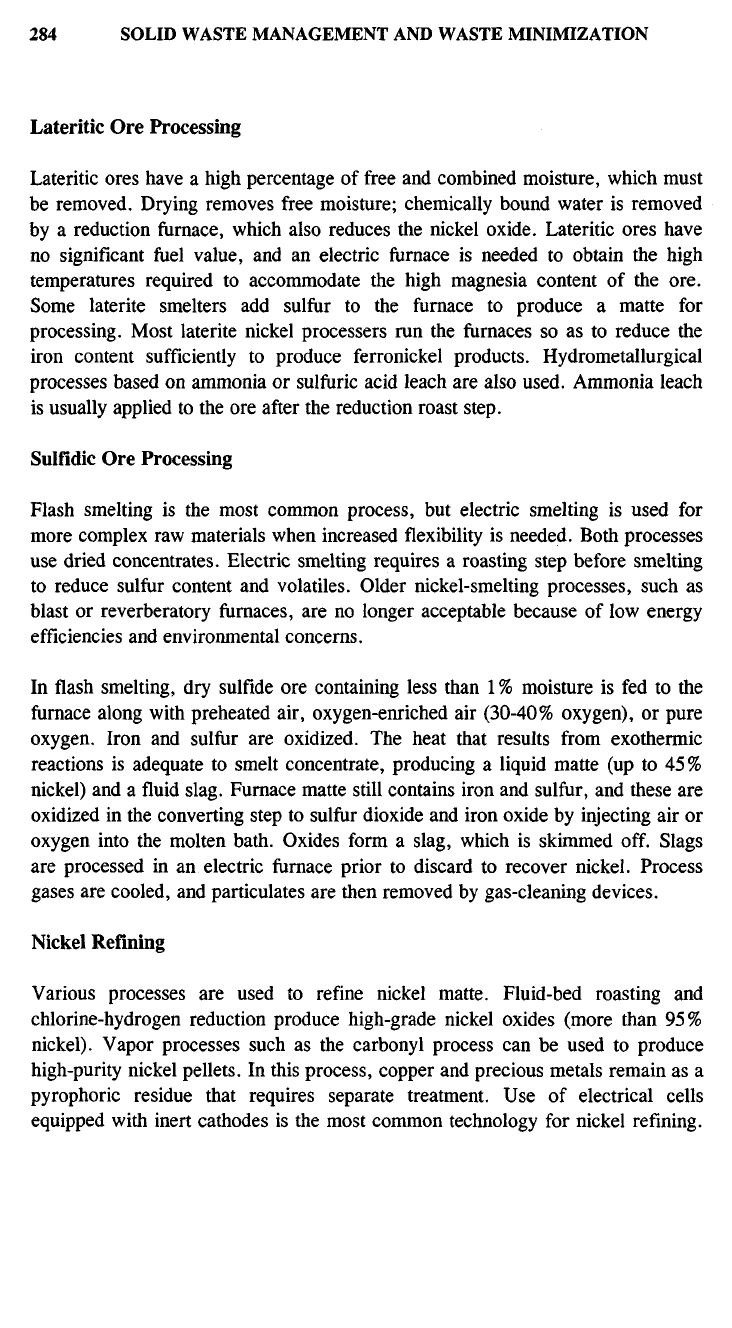
Lateritic Ore Processing
Lateritic ores have a high percentage of free and combined moisture, which must
be removed. Drying removes free moisture; chemically bound water is removed
by a reduction furnace, which also reduces the nickel oxide. Lateritic ores have
no significant fuel value, and an electric furnace is needed to obtain the high
temperatures required to accommodate the high magnesia content of the ore.
Some laterite smelters add sulfur to the furnace to produce a matte for
processing. Most laterite nickel processers run the furnaces so as to reduce the
iron content sufficiently to produce ferronickel products. Hydrometallurgical
processes based on ammonia or sulfixric acid leach are also used. Ammonia leach
is usually applied to the ore after the reduction roast step.
Sulfidic Ore Processing
Flash smelting is the most common process, but electric smelting is used for
more complex raw materials when increased flexibility is needed. Both processes
use dried concentrates. Electric smelting requires a roasting step before smelting
to reduce sulfur content and volatiles. Older nickel-smelting processes, such as
blast or reverberatory furnaces, are no longer acceptable because of low energy
efficiencies and environmental concerns.
In flash smelting, dry sulfide ore containing less than 1% moisture is fed to the
furnace along with preheated air, oxygen-enriched air (30-40% oxygen), or pure
oxygen. Iron and sulfur are oxidized. The heat that results from exothermic
reactions is adequate to smelt concentrate, producing a liquid matte (up to 45%
nickel) and a fluid slag. Furnace matte still contains iron and sulfur, and these are
oxidized in the converting step to sulfur dioxide and iron oxide by injecting air or
oxygen into the molten bath. Oxides form a slag, which is skimmed off. Slags
are processed in an electric furnace prior to discard to recover nickel. Process
gases are cooled, and particulates are then removed by gas-cleaning devices.
Nickel Refining
Various processes are used to refine nickel matte. Fluid-bed roasting and
chlorine-hydrogen reduction produce high-grade nickel oxides (more than 95%
nickel). Vapor processes such as the carbonyl process can be used to produce
high-purity nickel pellets. In this process, copper and precious metals remain as a
pyrophoric residue that requires separate treatment. Use of electrical cells
equipped with inert cathodes is the most common technology for nickel refining.
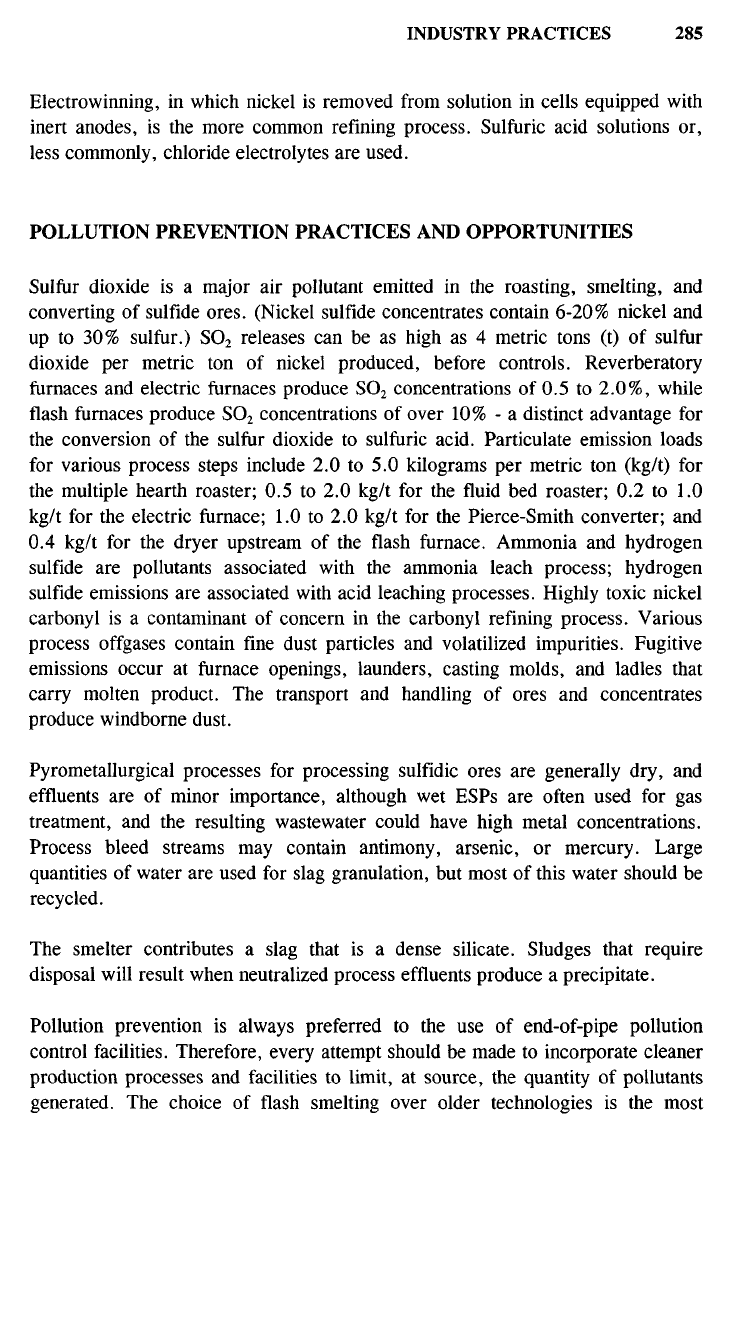
Electrowinning, in which nickel is removed from solution in cells equipped with
inert anodes, is the more common refining process. Sulfuric acid solutions or,
less commonly, chloride electrolytes are used.
POLLUTION PREVENTION PRACTICES AND OPPORTUNITIES
Sulfur dioxide is a major air pollutant emitted in the roasting, smelting, and
converting of sulfide ores. (Nickel sulfide concentrates contain 6-20% nickel and
up to 30% sulfur.) SO
2
releases can be as high as 4 metric tons (t) of sulfur
dioxide per metric ton of nickel produced, before controls. Reverberatory
furnaces and electric furnaces produce SO
2
concentrations of 0.5 to 2.0%, while
flash furnaces produce SO
2
concentrations of over 10% - a distinct advantage for
the conversion of the sulfur dioxide to sulfuric acid. Particulate emission loads
for various process steps include 2.0 to 5.0 kilograms per metric ton (kg/t) for
the multiple hearth roaster; 0.5 to 2.0 kg/t for the fluid bed roaster; 0.2 to 1.0
kg/t for the electric furnace; 1.0 to 2.0 kg/t for the Pierce-Smith converter; and
0.4 kg/t for the dryer upstream of the flash furnace. Ammonia and hydrogen
sulfide are pollutants associated with the ammonia leach process; hydrogen
sulfide emissions are associated with acid leaching processes. Highly toxic nickel
carbonyl is a contaminant of concern in the carbonyl refining process. Various
process offgases contain fine dust particles and volatilized impurities. Fugitive
emissions occur at furnace openings, launders, casting molds, and ladles that
carry molten product. The transport and handling of ores and concentrates
produce windborne dust.
Pyrometallurgical processes for processing sulfidic ores are generally dry, and
effluents are of minor importance, although wet ESPs are often used for gas
treatment, and the resulting wastewater could have high metal concentrations.
Process bleed streams may contain antimony, arsenic, or mercury. Large
quantities of water are used for slag granulation, but most of this water should be
recycled.
The smelter contributes a slag that is a dense silicate. Sludges that require
disposal will result when neutralized process effluents produce a precipitate.
Pollution prevention is always preferred to the use of end-of-pipe pollution
control facilities. Therefore, every attempt should be made to incorporate cleaner
production processes and facilities to limit, at source, the quantity of pollutants
generated. The choice of flash smelting over older technologies is the most
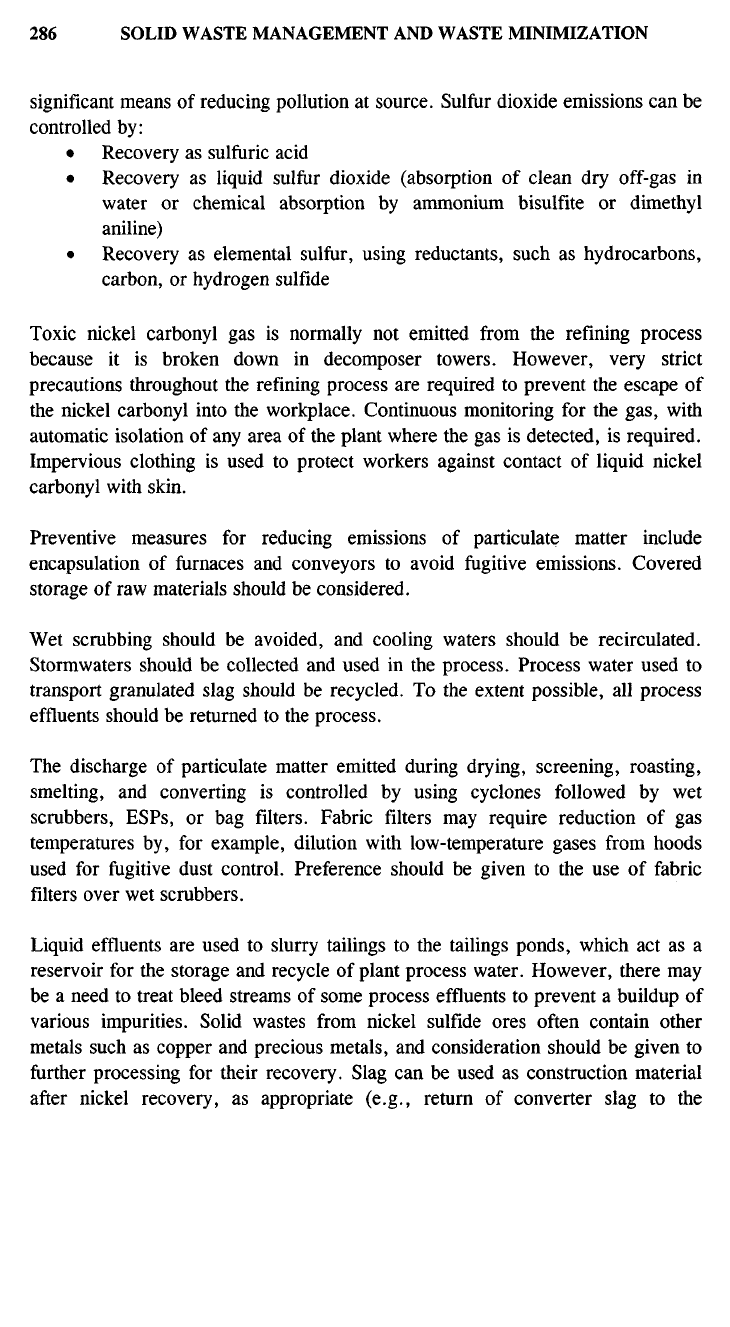
significant means of reducing pollution at source. Sulfur dioxide emissions can be
controlled by:
• Recovery as sulfuric acid
• Recovery as liquid sulfur dioxide (absorption of clean dry off-gas in
water or chemical absorption by ammonium bisulfite or dimethyl
aniline)
• Recovery as elemental sulfur, using reductants, such as hydrocarbons,
carbon, or hydrogen sulfide
Toxic nickel carbonyl gas is normally not emitted from the refining process
because it is broken down in decomposer towers. However, very strict
precautions throughout the refining process are required to prevent the escape of
the nickel carbonyl into the workplace. Continuous monitoring for the gas, with
automatic isolation of any area of the plant where the gas is detected, is required.
Impervious clothing is used to protect workers against contact of liquid nickel
carbonyl with skin.
Preventive measures for reducing emissions of particulate matter include
encapsulation of furnaces and conveyors to avoid fugitive emissions. Covered
storage of raw materials should be considered.
Wet scrubbing should be avoided, and cooling waters should be recirculated.
Stormwaters should be collected and used in the process. Process water used to
transport granulated slag should be recycled. To the extent possible, all process
effluents should be returned to the process.
The discharge of particulate matter emitted during drying, screening, roasting,
smelting, and converting is controlled by using cyclones followed by wet
scrubbers, ESPs, or bag filters. Fabric filters may require reduction of gas
temperatures by, for example, dilution with low-temperature gases from hoods
used for fugitive dust control. Preference should be given to the use of fabric
filters over wet scrubbers.
Liquid effluents are used to slurry tailings to the tailings ponds, which act as a
reservoir for the storage and recycle of plant process water. However, there may
be a need to treat bleed streams of some process effluents to prevent a buildup of
various impurities. Solid wastes from nickel sulfide ores often contain other
metals such as copper and precious metals, and consideration should be given to
further processing for their recovery. Slag can be used as construction material
after nickel recovery, as appropriate (e.g., return of converter slag to the
